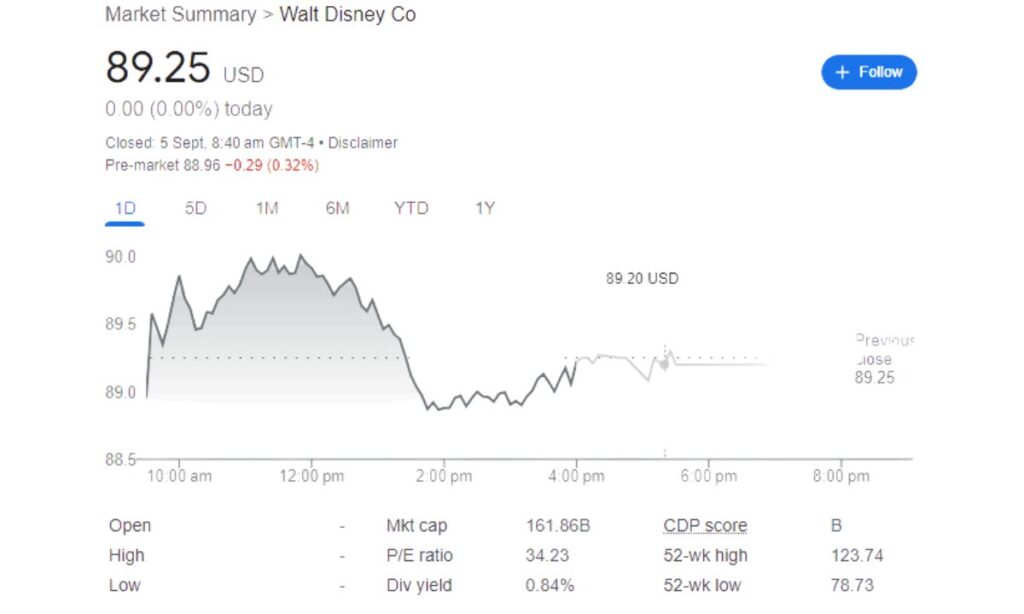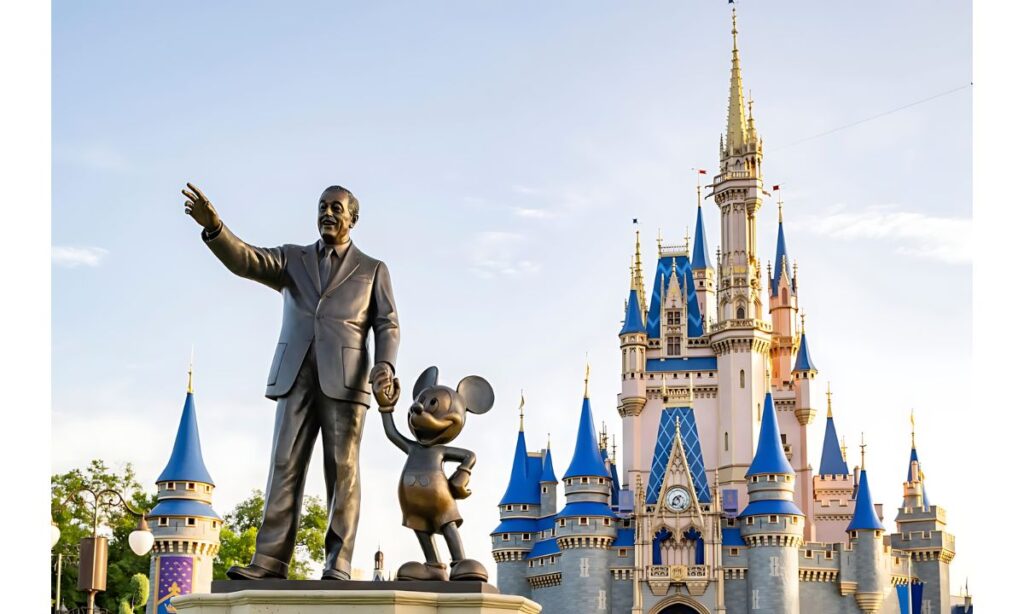In the magical world of finance, Disney’s stock performance has captivated investors and analysts alike. This in-depth exploration delves into the House of Mouse’s financial journey, leveraging Fintechzoom Dis Stock insights to paint a comprehensive picture of Disney’s market standing.
From theme park thrills to streaming chills, we’ll unpack the factors driving Disney’s stock movements and what the future might hold for this entertainment powerhouse.
Understanding Fintechzoom Dis Stock
Fintechzoom has emerged as a go-to resource for savvy investors seeking robust analysis of Disney stock (DIS). This fintech platform offers a treasure trove of data, combining cutting-edge algorithms with expert insights to track Disney’s financial health and stock movements.
Why Fintechzoom Dis Stock Analysis Matters
- Real-time data updates
- Comprehensive historical trends
- Expert commentary on market influences
- Predictive modeling for future performance
Investors leveraging Fintechzoom Dis Stock insights gain a competitive edge, accessing a blend of quantitative and qualitative analysis that paints a fuller picture of Disney’s market position.
Disney’s Stock Performance: Growth and Challenges
Disney’s journey from a small animation studio to a global entertainment behemoth is reflected in its stock’s historical performance. Let’s chart the course of Disney’s financial voyage:
| Year | Milestone | Impact on Stock |
| 1957 | IPO at $13.88 per share | Established Disney as a public company |
| 1995 | Acquisition of Capital Cities/ABC | Boosted media presence, stock surged |
| 2006 | Acquisition of Pixar | Reinvigorated animation division |
| 2009 | Marvel Entertainment purchase | Expanded IP portfolio significantly |
| 2012 | Lucasfilm acquisition | Added Star Wars franchise to roster |
| 2019 | Launch of Disney+ | Pivotal move into streaming market |
Recent Trends and Influencing Factors
Disney’s stock performance in recent years has been a rollercoaster ride, influenced by:
- The COVID-19 pandemic’s impact on theme parks and cruise lines
- The meteoric rise of Disney+ subscribers
- Intense competition in the streaming wars
- Shifts in consumer entertainment preferences
Case Study: Disney+ Launch Impact When Disney+ debuted in November 2019, Disney’s stock price surged from $138 to $151 within a month. This 9.4% increase reflected investor confidence in Disney’s digital expansion strategy.
Adapting to Market Dynamics
Disney’s ability to pivot has been crucial to its stock performance. The company’s strategic shifts include:
- Doubling down on direct-to-consumer models
- Restructuring to prioritize streaming services
- Navigating pandemic-related challenges in parks and experiences
- Leveraging intellectual property across multiple platforms
“In the world of entertainment, standing still is the same as moving backward.” – Bob Iger, Former Disney CEO
This adaptability has helped maintain investor confidence, even as Disney’s stock price faced volatility.
Factors Influencing Disney’s Stock Price

Disney’s stock price dances to the tune of various factors. Streaming wars heat up the market, with Disney+ subscriber numbers often stealing the show. Theme park attendance swings with economic tides and travel trends. Box office hits (or misses) can send ripples through investor sentiment.
Don’t forget the magic of Disney’s brand power – it’s a force that can cushion blows or amplify wins. Keep an eye on content costs too; they’re the behind-the-scenes player that can make or break profit margins.
Impact of Market Trends
Disney’s stock price doesn’t exist in a vacuum. It’s buffeted by broader market trends, including:
- The overall growth of the streaming industry
- Economic factors affecting discretionary spending
- Technological advancements in content delivery
- Shifts in advertising landscapes
Role of Business Segments
Disney’s diverse revenue streams play a crucial role in its stock performance. Let’s break down the key segments:
- Media Networks: Including ABC and ESPN
- Parks, Experiences and Products: Theme parks, resorts, and merchandise
- Studio Entertainment: Film and TV content production
- Direct-to-Consumer & International: Disney+, Hulu, and international operations
Each segment’s performance can sway Disney’s stock price, with investors closely watching metrics like park attendance, streaming subscriber growth, and box office receipts.
Influence of External Events
External factors can significantly impact Disney’s stock movements:
- Global economic conditions affecting travel and entertainment spending
- Regulatory changes in media and entertainment industries
- Geopolitical events affecting international operations
- Public health crises (as seen with the COVID-19 pandemic)
Key Financial Metrics for Evaluating Disney’s Stock
When sizing up Disney stock, smart investors look beyond the surface. The P/E ratio tells a tale of market expectations – is Disney priced for perfection or poised for growth? Revenue growth across segments paints a picture of Disney’s diversified strength.
Profit margins reveal how efficiently the House of Mouse turns magic into money. And don’t overlook cash flow – it’s the lifeblood that fuels future innovations and weathering storms. These metrics together form a financial spell book for decoding Disney’s true value.
Price-to-Earnings (P/E) Ratio
Disney’s P/E ratio is a crucial metric for investors. As of September 2024, Disney’s P/E ratio stands at 28.5, compared to the industry average of 22.3. This higher ratio suggests that investors are willing to pay a premium for Disney stock, possibly due to expectations of future growth, particularly in the streaming sector.
Dividend Yield and Its Significance
Historically, Disney has been a reliable dividend payer, attracting income-focused investors. However, the pandemic led to a suspension of dividends in 2020. As of September 2024, Disney has reinstated its dividend, currently yielding 1.2%. This reinstatement has significantly boosted Disney’s stock appeal, particularly among value and income investors.
Revenue and Profit Margins
Disney’s financial health is reflected in its revenue growth and profit margins:
| Metric | FY 2023 | FY 2022 | YoY Change |
| Revenue | $88.9 billion | $82.7 billion | 7.5% |
| Net Income | $4.2 billion | $3.1 billion | 35.5% |
| Operating Margin | 11.2% | 9.8% | 1.4% increase |
These figures demonstrate a strong recovery post-pandemic, with significant growth in both revenue and profitability. The improved operating margin indicates more efficient operations across Disney’s business segments.
Evaluating Disney Stock: Key Considerations

Thinking of joining the Disney investment family? It’s not just about crunching numbers. Consider Disney’s competitive moat – those beloved characters and franchises aren’t easily replicated. How’s Disney faring in the streaming sprint against tech giants?
Theme parks might seem old school, but they’re experiential gold mines in a digital world. Peek into Disney’s crystal ball – upcoming releases, park expansions, and tech innovations could be tomorrow’s stock catalysts. And remember, in the kingdom of entertainment, adaptability reigns supreme.
Industry Comparison
When assessing Disney’s stock performance, it’s crucial to compare it with industry peers:
- Netflix: The streaming pioneer
- Comcast: A diversified media competitor
- ViacomCBS: Another major player in content and distribution
Disney’s competitive advantages include:
- Unparalleled intellectual property portfolio
- Synergies across various business segments
- Strong brand recognition globally
Future Growth Potential
Disney’s growth prospects hinge on several factors:
- Expansion of streaming services: Disney+ subscriber growth in international markets
- Theme park innovations: New attractions and experiences to drive attendance
- Content creation: Leveraging Marvel, Star Wars, and other franchises
- Technology integration: Enhancing customer experiences through AR/VR
Investment Strategy and Risk Assessment
Investors considering Disney stock should weigh:
- Short-term volatility vs. long-term growth potential
- The impact of economic cycles on Disney’s various segments
- Competitive pressures in the streaming and entertainment landscapes
Key Risk Factors and Considerations for Investing in Disney Stock
Every fairy tale has its dragons, and Disney’s stock is no exception. Content creation costs are a hungry beast, always demanding more. Economic downturns can turn dream vacations into distant wishes, hitting parks and cruises hard. The streaming landscape is a battlefield – can Disney+ keep its crown amid fierce competition?
Regulatory winds can shift, potentially tangling Disney’s expansion plans. And in a world of rapid tech changes, staying relevant is a never-ending quest. Wise investors keep these challenges in mind while charting their course through Disney’s financial kingdom.
Company-Specific Risks
- High content production costs
- Integration challenges from acquisitions
- Succession planning and management changes
Economic and Competitive Pressures
- Recession impacts on discretionary spending
- Intensifying streaming competition
- Shifts in traditional TV viewership and advertising
Regulatory and Legal Risks
- Antitrust concerns in media consolidation
- International regulatory challenges
- Intellectual property protection in global markets
Disney’s Future Outlook: Strategic Growth and Fintechzoom Dis Stock Insights

Fintechzoom Dis Stock analysis suggests a cautiously optimistic outlook for Disney stock. The platform’s latest data indicates a potential 15% upside in Disney’s stock price over the next 12 months, based on the company’s strategic initiatives and market positioning. Potential catalysts for stock growth include:
- Continued Disney+ subscriber expansion, particularly in emerging markets
- Recovery and growth in theme park attendance, driven by new attractions and experiences
- Successful monetization of intellectual property across platforms, including merchandising and licensing
Areas of concern that Disney must address include the high costs associated with content production for streaming services and the need to balance traditional media revenue streams with the growth of direct-to-consumer offerings.
Final Thoughts
Disney’s stock performance reflects its journey as an entertainment juggernaut adapting to a rapidly changing landscape. Fintechzoom Dis Stock insights provide valuable perspectives on Disney’s financial health and future prospects. As the company continues to navigate the streaming wars, theme park operations, and content creation, investors should stay informed and agile.
“The rearview mirror is always clearer than the windshield.” – Warren Buffett
This quote reminds us that while historical performance is informative, the future of Disney stock will be shaped by the company’s ability to innovate, adapt, and grow in an ever-evolving entertainment landscape. For those considering investing in Disney, thorough research, including leveraging tools like Fintechzoom Dis Stock analysis, will be key to making informed decisions in this magical yet complex market.
Also Read : Explore Jacques Garcia Net Worth 2024 – The Interior Designer’s Financial Success Story!

Howdy is the founder and lead writer behind the independent blog tvspluto.com